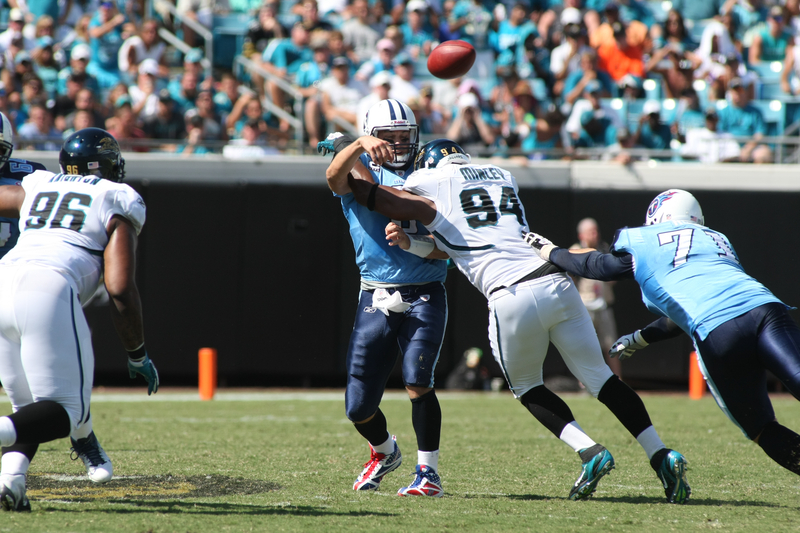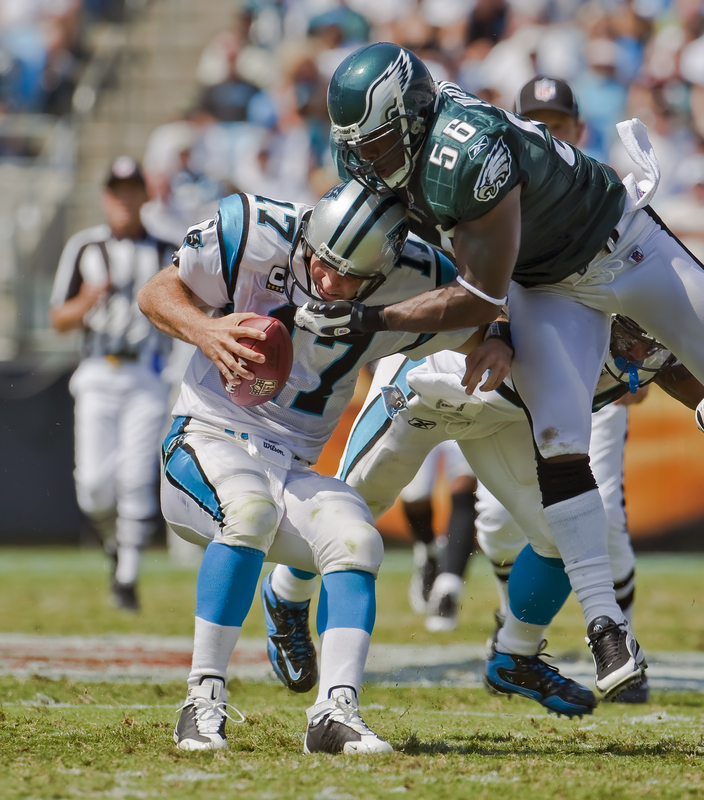Last updated on October 29th, 2023 at 10:04 am
In the National Football League, it’s illegal for a defensive player to contact a quarterback after the ball has been passed or thrown if a defensive player makes illegal contact with the passer, a 15-yard penalty with an automatic first down.
The NFL rules specify that if a defensive player makes contact with a passer, they can’t try to cause undue harm to the player. If they tackle the passer, they should avoid landing on them with their entire body weight. This tackle can be considered “stuffing” the quarterback into the ground. Defensemen also can’t hit a quarterback in the head or neck area.
One of the most important places that a defender needs to avoid is the quarterback’s legs. Referees are always looking to make sure that defensive backs don’t hit the quarterback in the knees or ankles, which could cause soft-tissue severe injuries like a torn ACL.
Where Can a Defensive Player Hit the Quarterback?
Since roughing the passer penalties is often subjective, some defensive players feel anxious trying to hit quarterbacks and force a fumble based on referee discretion. However, there are several ways a defensive player can hit the quarterback without getting a penalty.
Defenses can try to swat at the ball while the quarterback is throwing to force a fumble. The rulebook specifies that the defensive player cannot club the arm of the quarterback. So, wrapping the upper torso or arms of the quarterback is allowed.
Players can also tackle the quarterback without getting a roughing the passer call if they land without putting their entire body weight on the quarterback. Suppose a linebacker sacks the passer and immediately rolls away from the tackle or braces in a way to minimize the blow. In that case, they can effectively complete a tackle without getting a penalty.
As always, defensive players must never touch the head, neck, or facemask of another player. Not hitting the head, neck, or facemasks is especially true for hits on the quarterback.
Essential Examples of Roughing the Passer
As far as rules go, roughing the passer is one that seems to evolve after legal in-game hits cause star quarterbacks to miss several games. For example, the NFL included a provision in the rule regarding low hits in the 2009 offseason, after Bernard Pollard of the Kansas City Chiefs lunged for New England Patriot’s quarterback, Tom Brady’s knees in a game in 2008. The tackle tore Brady’s ACL, which took him out for the rest of the season. Brady’s injury is one of the reasons the Patriots did not make the 2008 playoffs.
Similarly, Anthony Barr’s hit on Aaron Rodgers in 2017 caused the league to adopt the “Aaron Rodgers Rule,” which prohibits defenders from landing on a passer with their entire body weight. In a week one game between the Minnesota Vikings and the Green Bay Packers, Barr hit Rodgers and forced him to land on his right shoulder, breaking his collarbone. The injury caused Rodgers to miss most of the rest of the season.
The Problem for Defenders
With the consistent evolutions of the rule, it’s made it hard for defenders to sack the quarterback safely. In a 2018 game between the Oakland Raiders and Miami Dolphins, the rule calling was up in the air. Dolphins’ defensive lineman William Hayes attempted to sack Raiders quarterback Derek Carr. However, conscious of the bodyweight rule, he tried to roll off of Carr’s back and accidentally tore his ACL in the process. The injury effectively ended Hayes’ season just as it was starting.
That same year, Clay Matthews received some questionable roughing the passer penalties. The new rule specifies that defensemen who tackle the quarterback should immediately roll off them, which is now common in the NFL.
In Conclusion about Roughing the Passer in Football
Roughing the passer penalties occur when any defensive player makes illegal contact with a quarterback. This rule is constantly evolving, and since there have been several rule changes, it’s often hard for defenses to adapt. Adapting this play for defensive players is frustrating because they have to be aggressive and also non-aggressive when coming towards the QB, . This penalty is a personal foul, which results in 15 yards and a first down for the offensive team.
Related Topics
What is the NFL Passer Rating?
What is a Play Action Play in Football?
NFL Teams Without Cheerleaders
What is a False Start in Football?
What is a Hail Mary in Football?
What is an Audible in Football?
Football Players Taping their Arms
Why Do Football Players Wear Towels?
What is a Field Goal in Football?
What are Special Teams in Football?
Greg Kristan, owner of The Stadium Reviews, LLC and TM Blast, LLC, brings his extensive experience visiting over half of the MLB ballparks, along with numerous MLS, NHL, NBA, and NFL venues, to provide in-depth coverage on the bag policy, food options, and parking. He has also been interviewed about his experiences on several sports podcasts.



